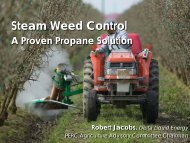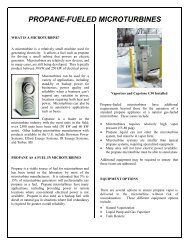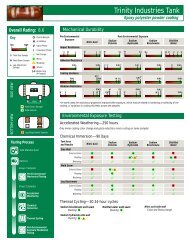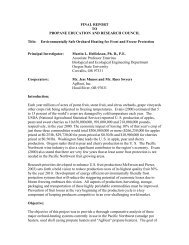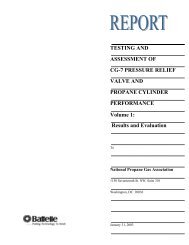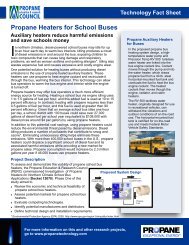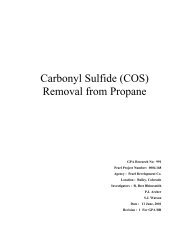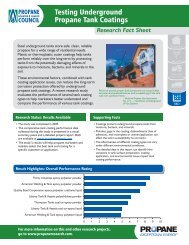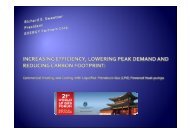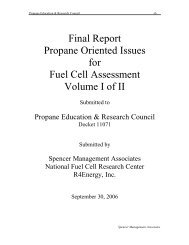Code Approval of Composite Propane Cylinders for Indoor Use ...
Code Approval of Composite Propane Cylinders for Indoor Use ...
Code Approval of Composite Propane Cylinders for Indoor Use ...
Create successful ePaper yourself
Turn your PDF publications into a flip-book with our unique Google optimized e-Paper software.
Task 2 – Conduct Preliminary <strong>Composite</strong> Cylinder Fire TestingThe purpose <strong>of</strong> Task 2 was to conduct preliminary fire per<strong>for</strong>mance testing <strong>of</strong> the compositecylinder to provide background in<strong>for</strong>mation to the Advisory Group and NPGA.Preliminary TestingBattelle and ThermDyne per<strong>for</strong>med preliminary fire testing <strong>for</strong> the project from February 17 toMarch 3, 2005, at the Mining Resource Engineering Limited’s test site north <strong>of</strong> Kingston,Ontario, Canada. Six conventional steel cylinders, 18 two-piece, linerless composite cylinders,and 11 one-piece, lined cylinders were tested in various fire exposure conditions, orientations,and fill levels. All cylinders were nominally 20 pound capacity (45 to 47 pound water capacity).The three fire conditions that were used in the preliminary fire tests to mimic a liquidhydrocarbon pool fire are described in Table 2 and a summary <strong>of</strong> the test plan is provided inTable 3.In the preliminary testing, the test cylinders were oriented either vertically (Figure 1) orhorizontally (Figure 2). In the horizontal position, the flame was directed at the side (as shown inFigure 2), at the valve, or at the base <strong>for</strong> the different tests.No steel cylinders ruptured during the testing. The relief valves opened between 375 and 400psig. Some relief valves re-closed above 300 psig, and some didn’t re-close until 100 psig. In alltests, the steel cylinders emptied be<strong>for</strong>e the cylinder walls s<strong>of</strong>tened and thinned enough torupture. One steel cylinder did show a bulge (Figure 3).When tested vertically and with a nominal fill level <strong>of</strong> 75 percent, the two-piece, linerlesscomposite cylinder did not fail (Figure 4). During these tests, propane began to leak around thevalve-cylinder connection and diffused through the cylinder walls after reaching peak pressuresbetween 98 psig and 118 psig. Figure 4 shows that the propane continues to permeate throughthe wall even though the cylinder pressure was essentially zero gage. The outer protective jacketwas consumed on all composite cylinder tests.<strong>Composite</strong> <strong>Propane</strong> <strong>Cylinders</strong> 9 February 2007<strong>for</strong> <strong>Indoor</strong> <strong>Use</strong> — Phase IIBattelle



